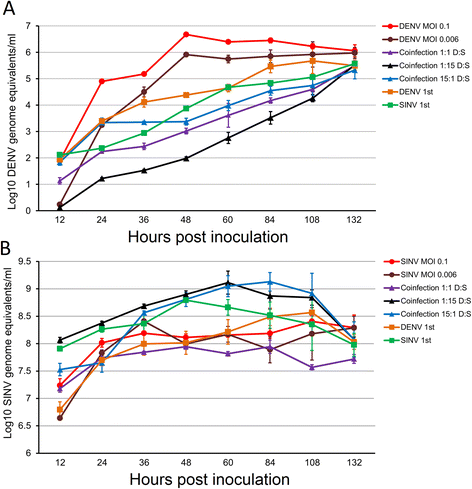Sindbis virus interferes with dengue 4 virus replication and its potential transmission by Aedes albopictus
- PMID: 25633862
- PMCID: PMC4316403
- DOI: 10.1186/s13071-015-0667-y
Sindbis virus interferes with dengue 4 virus replication and its potential transmission by Aedes albopictus
Abstract
Background: Mosquitoes transmit a number of arboviruses associated with disease outbreaks in humans and other animals. The majority of medically important arboviruses belong to three families: Togaviridae, Flaviviridae and Bunyaviridae. Several members of these families have overlapping distributions and share common vectors, increasing the potential for arboviral coinfections. This study examined how two model viruses: Sindbis virus (SINV, Togaviridae: Alphavirus) and dengue-4 virus (DENV-4, Flaviviridae: Flavivirus) may interact in C6/36 Aedes albopictus cells and in the mosquito vector Ae. albopictus.
Methods: C6/36 cells were coinfected, superinfected, or singly infected with SINV and DENV-4 and the two viruses quantified at different time points. Four to seven day old adult females of Ae. albopictus were also fed blood containing one or both viruses and viral infection and dissemination rates determined.
Results: Sindbis virus suppressed replication of DENV-4 in C6/36 Ae. albopictus cells with greater inhibition occurring when the two arboviruses were inoculated simultaneously compared to sequentially. In addition, Ae. albopictus simultaneously exposed to both arboviruses had significantly lower DENV-4 infection and population dissemination rates compared to those exposed to DENV-4 alone.
Conclusion: These results suggest that certain Alphaviruses may interfere with DENV-4 transmission by suppressing its replication and increasing vector refractoriness. The findings provide important insights into the potential contribution of mixed arboviral infections to DENV transmission dynamics.
Figures



Similar articles
-
Infection and dissemination of dengue virus type 2 in Aedes aegypti, Aedes albopictus, and Aedes scutellaris from the Torres Strait, Australia.J Am Mosq Control Assoc. 2007 Dec;23(4):383-8. doi: 10.2987/5598.1. J Am Mosq Control Assoc. 2007. PMID: 18240514
-
Vector competence of the Aedes aegypti population from Santiago Island, Cape Verde, to different serotypes of dengue virus.Parasit Vectors. 2015 Feb 19;8:114. doi: 10.1186/s13071-015-0706-8. Parasit Vectors. 2015. PMID: 25888847 Free PMC article.
-
Evaluation of Simultaneous Transmission of Chikungunya Virus and Dengue Virus Type 2 in Infected Aedes aegypti and Aedes albopictus (Diptera: Culicidae).J Med Entomol. 2015 May;52(3):447-51. doi: 10.1093/jme/tjv017. Epub 2015 Mar 15. J Med Entomol. 2015. PMID: 26334820 Free PMC article.
-
Critical review of the vector status of Aedes albopictus.Med Vet Entomol. 2004 Sep;18(3):215-27. doi: 10.1111/j.0269-283X.2004.00513.x. Med Vet Entomol. 2004. PMID: 15347388 Review.
-
RNA interference, arthropod-borne viruses, and mosquitoes.Virus Res. 2004 Jun 1;102(1):65-74. doi: 10.1016/j.virusres.2004.01.017. Virus Res. 2004. PMID: 15068882 Review.
Cited by
-
Co-distribution and co-infection of chikungunya and dengue viruses.BMC Infect Dis. 2016 Mar 3;16:84. doi: 10.1186/s12879-016-1417-2. BMC Infect Dis. 2016. PMID: 26936191 Free PMC article. Review.
-
Factors Affecting Arbovirus Midgut Escape in Mosquitoes.Pathogens. 2023 Jan 31;12(2):220. doi: 10.3390/pathogens12020220. Pathogens. 2023. PMID: 36839492 Free PMC article. Review.
-
Virological and Immunological Outcomes of Coinfections.Clin Microbiol Rev. 2018 Jul 5;31(4):e00111-17. doi: 10.1128/CMR.00111-17. Print 2018 Oct. Clin Microbiol Rev. 2018. PMID: 29976554 Free PMC article. Review.
-
In Vitro and In Vivo Coinfection and Superinfection Dynamics of Mayaro and Zika Viruses in Mosquito and Vertebrate Backgrounds.J Virol. 2023 Jan 31;97(1):e0177822. doi: 10.1128/jvi.01778-22. Epub 2023 Jan 4. J Virol. 2023. PMID: 36598200 Free PMC article.
-
The recently identified flavivirus Bamaga virus is transmitted horizontally by Culex mosquitoes and interferes with West Nile virus replication in vitro and transmission in vivo.PLoS Negl Trop Dis. 2018 Oct 24;12(10):e0006886. doi: 10.1371/journal.pntd.0006886. eCollection 2018 Oct. PLoS Negl Trop Dis. 2018. PMID: 30356234 Free PMC article.
References
Publication types
MeSH terms
LinkOut - more resources
Full Text Sources
Other Literature Sources
Medical

